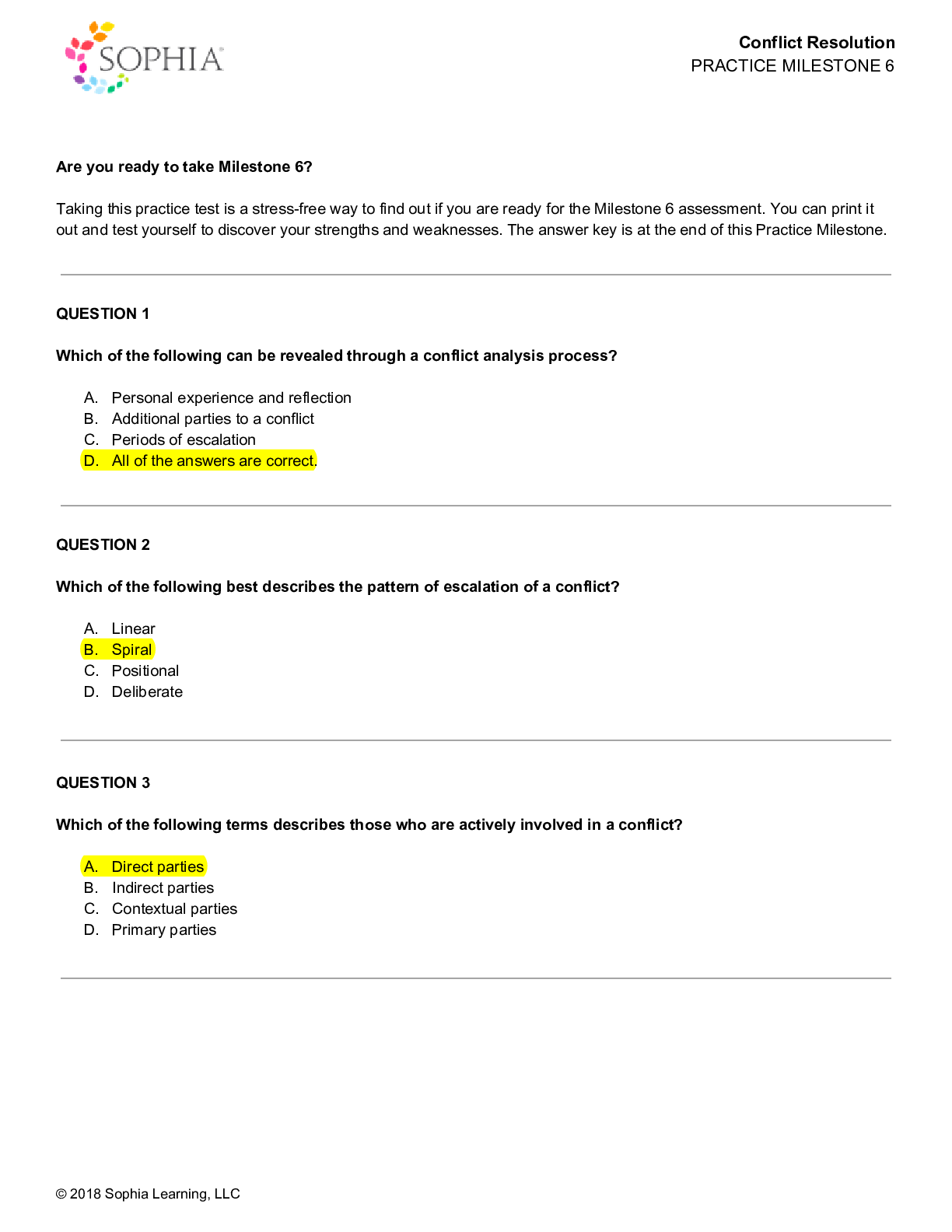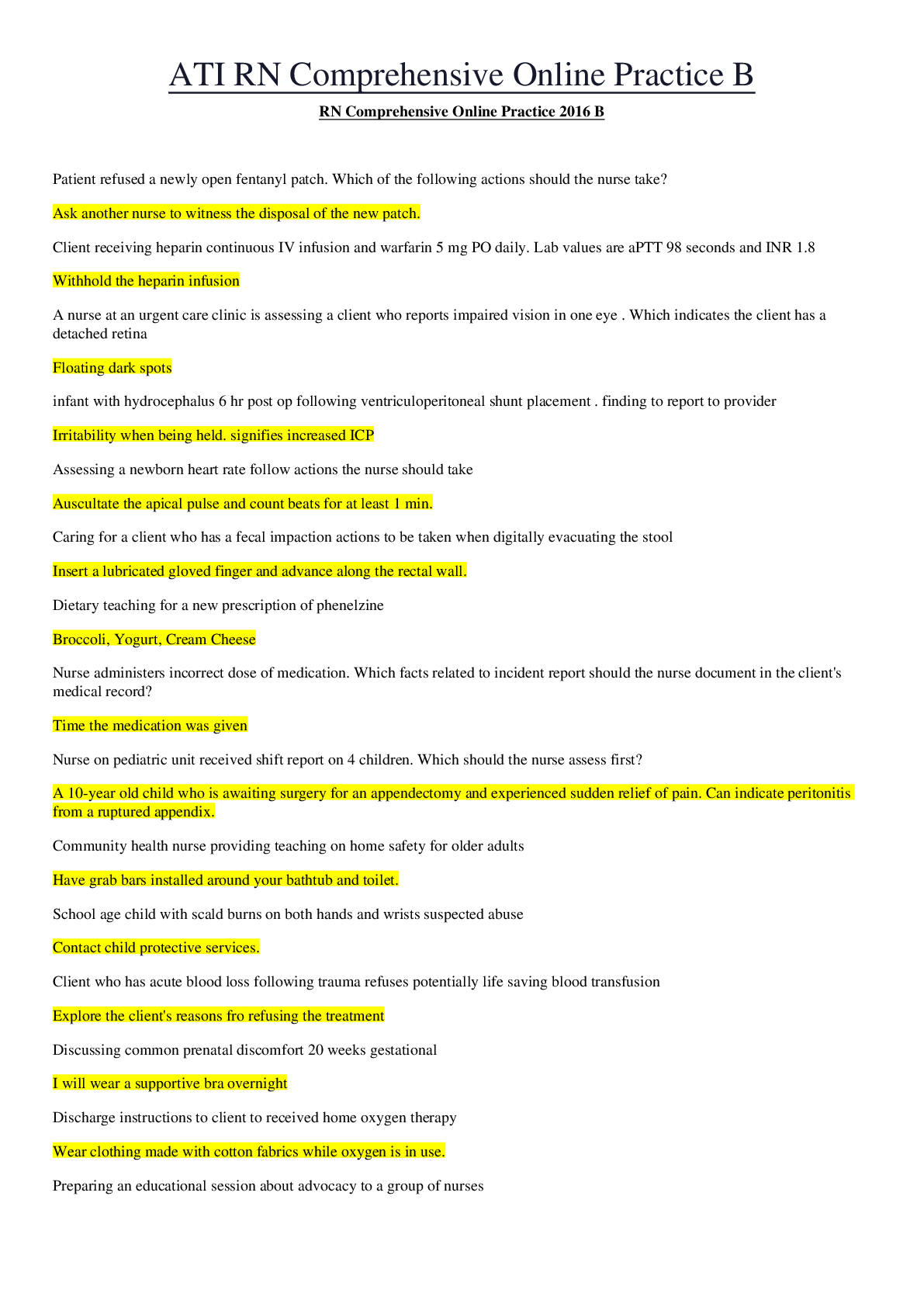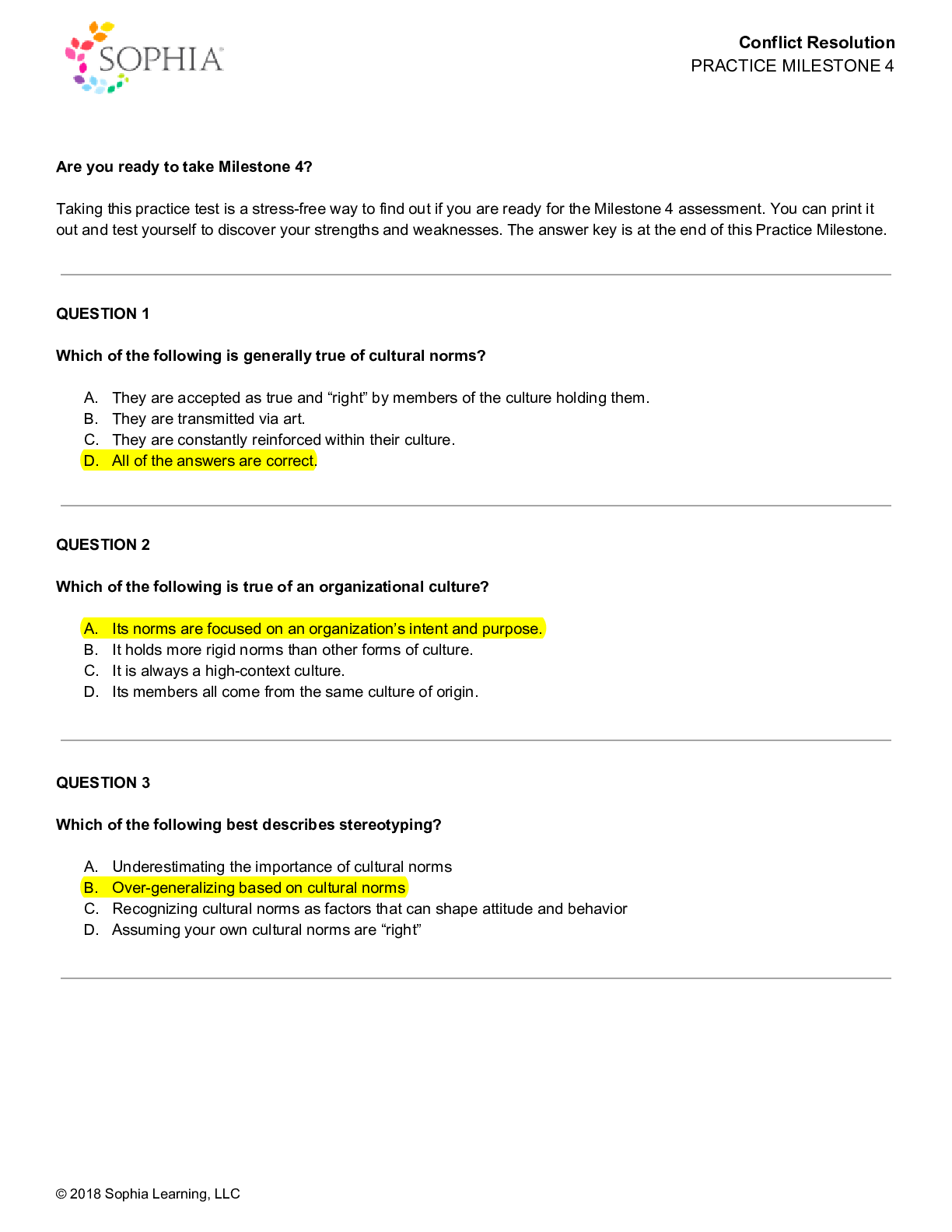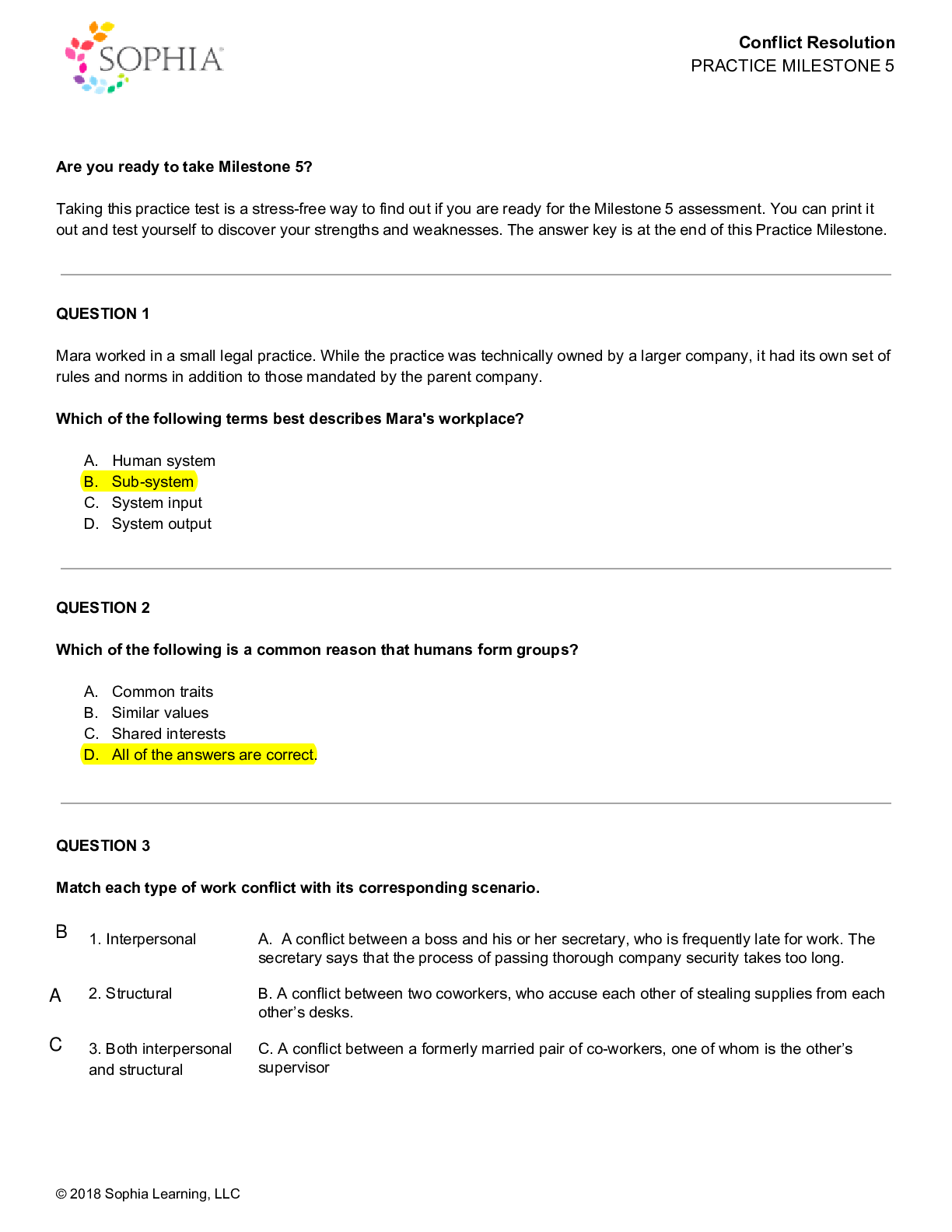Business > EXAM > GEN 499 Conflict_Resolution_Practice_Test_Milestone_6_{2020} - Graded A | GEN499 Conflict_Resolution (All)
GEN 499 Conflict_Resolution_Practice_Test_Milestone_6_{2020} - Graded A | GEN499 Conflict_Resolution_Practice_Test_Milestone_6_{2020}
Document Content and Description Below
Conflict Resolution PRACTICE MILESTONE 6 Are you ready to take Milestone 6? Taking this practice test is a stress-free way to find out if you are ready for the Milestone 6 assessment. You can print... it out and test yourself to discover your strengths and weaknesses. The answer key is at the end of this Practice Milestone. QUESTION 1 Which of the following can be revealed through a conflict analysis process? A. Personal experience and reflection B. Additional parties to a conflict C. Periods of escalation D. All of the answers are correct. QUESTION 2 Which of the following best describes the pattern of escalation of a conflict? A. Linear B. Spiral C. Positional D. Deliberate QUESTION 3 Which of the following terms describes those who are actively involved in a conflict? A. Direct parties B. Indirect parties C. Contextual parties D. Primary parties © 2018 Sophia Learning, LLCConflict Resolution PRACTICE MILESTONE 6 QUESTION 4 Contrasting and Common Beliefs, Positions, and Interests A. Interests and beliefs are often unrelated. B. An interest is a need, and a belief is one way of meeting that need. C. A belief is a need, and an interest is one way of meeting that need. D. A belief can be a type of interest. QUESTION 5 Which of the following is true of conflicts at a “stalemate” stage? A. Escalation ceases B. Attitudes become more positive C. Positions harden D. Resolution becomes impossible QUESTION 6 Which of the following is NOT an objective of a conflict consulting process? A. Building conflict resolution skills B. Advocating for a change in values C. Allowing the party a chance to express feelings about the conflict D. Creating strategies for conflict resolution © 2018 Sophia Learning, LLCConflict Resolution PRACTICE MILESTONE 6 QUESTION 7 Louis, a party to a long standing conflict, was being interviewed by a mediator as part of a conflict analysis. During his interview, Louis said, “Look, the problem really didn’t start out so big. It was just a dispute about loud music in the neighborhood. I don’t play my music loud at all, but people started getting upset about it. Maybe they just don't like the music I play, who knows. But after that, the police started coming to my house all the time. I kept a record of every visit … there were ten in a month. It seems like people were calling the cops on me for no reason, and the police just took them at their word and came over to hassle me. It’s tough when everyone treats you like a criminal and you’ve done nothing wrong.” Place the following types of information given by Louis in his interview in the correct order. 1. __________ A. Facts 2. __________ B. Perception of facts 3. __________ C. Feelings QUESTION 8 Which of the following may be used to help create buy-in to a conflict resolution process? A. Common interests B. Spiraling escalation C. Hardening of positions D. Conflicting values QUESTION 9 Which of the following is NOT an option when deciding on a conflict resolution process to fit a given situation? A. Selecting a standard conflict resolution process B. Modifying an existing conflict resolution process C. Changing core assumptions and approaches of a process D. Allowing parties to decide if a conflict resolution is a valid option for their conflict © 2018 Sophia Learning, LLCConflict Resolution PRACTICE MILESTONE 6 QUESTION 10 Which of the following is likely to be seen as a potential benefit to remaining in a long-term conflict? A. Reducing escalation B. Reinforcing a sense of identity C. Concealing positions D. Building mutual understanding QUESTION 11 Which of the following is NOT an effective communication tool for conflict prevention or reduction in daily life? A. Asking clarifying questions B. Using I-statements C. Listening actively D. All of the answers are correct. QUESTION 12 Which of the following is a disadvantage of consensus-based decision making? A. Uncovering a wide range of interests regarding the decision B. Generating a best-possible agreement for a given group C. Providing all parties an opportunity to express their feelings D. None of the answers is correct. QUESTION 13 Select the true statement about the Third Side approach. A. The Third Side approach must be facilitated by legal officials if it's used in a mediation. B. The primary goal of the Third Side approach is to eliminate conflict. C. The Third Side approach aims to transform the way conflict is expressed in a community. D. The Third Side approach keeps its focus on the direct parties in a conflict. © 2018 Sophia Learning, LLCConflict Resolution PRACTICE MILESTONE 6 QUESTION 14 Match each function of the Third Side approach to conflict resolution with its corresponding role. 1. Resolving conflict A. Bridge builder 2. Containing conflict B. Healer C. Referee QUESTION 15 Which of the following is NOT a topic that would likely be addressed through a courageous/difficult conversations process? A. A dispute over an act of vandalism B. Strong interpersonal conflict C. Conflict over gender roles D. Conflict over racial attitudes QUESTION 16 Which of the following would likely NOT be considered a stakeholder in a stakeholders’ process regarding patient care in a hospital? A. Hospital attorneys B. Hospital cafeteria staff C. Patients of the hospital D. Doctors at the hospital QUESTION 17 Which of the following is NOT a possible reason for parties to be reluctant to engage in a conflict resolution process? A. Anxiety over meeting with the other party B. Fear of loss as a result of the process C. Perception of ownership in the process D. None of the answers is correct. © 2018 Sophia Learning, LLCConflict Resolution PRACTICE MILESTONE 6 QUESTION 18 Which of the following is NOT a true statement about interviews with parties as part of a conflict analysis? A. The intervener should try to understand parties’ differing interpretations of facts. B. Parties have the opportunity to discuss the benefits they perceive from remaining in conflict. C. Parties have a chance to discuss their feelings in interviews. D. The intervener should not keep the contents of interviews confidential. QUESTION 19 Issues that are best addressed through courageous conversations are most often based on which of the following? A. Religion B. Values C. Resources D. Positions [Show More]
Last updated: 2 years ago
Preview 1 out of 7 pages

Buy this document to get the full access instantly
Instant Download Access after purchase
Buy NowInstant download
We Accept:

Reviews( 0 )
$11.50
Can't find what you want? Try our AI powered Search
Document information
Connected school, study & course
About the document
Uploaded On
Feb 11, 2021
Number of pages
7
Written in
Additional information
This document has been written for:
Uploaded
Feb 11, 2021
Downloads
0
Views
79








 – University of the People.png)










